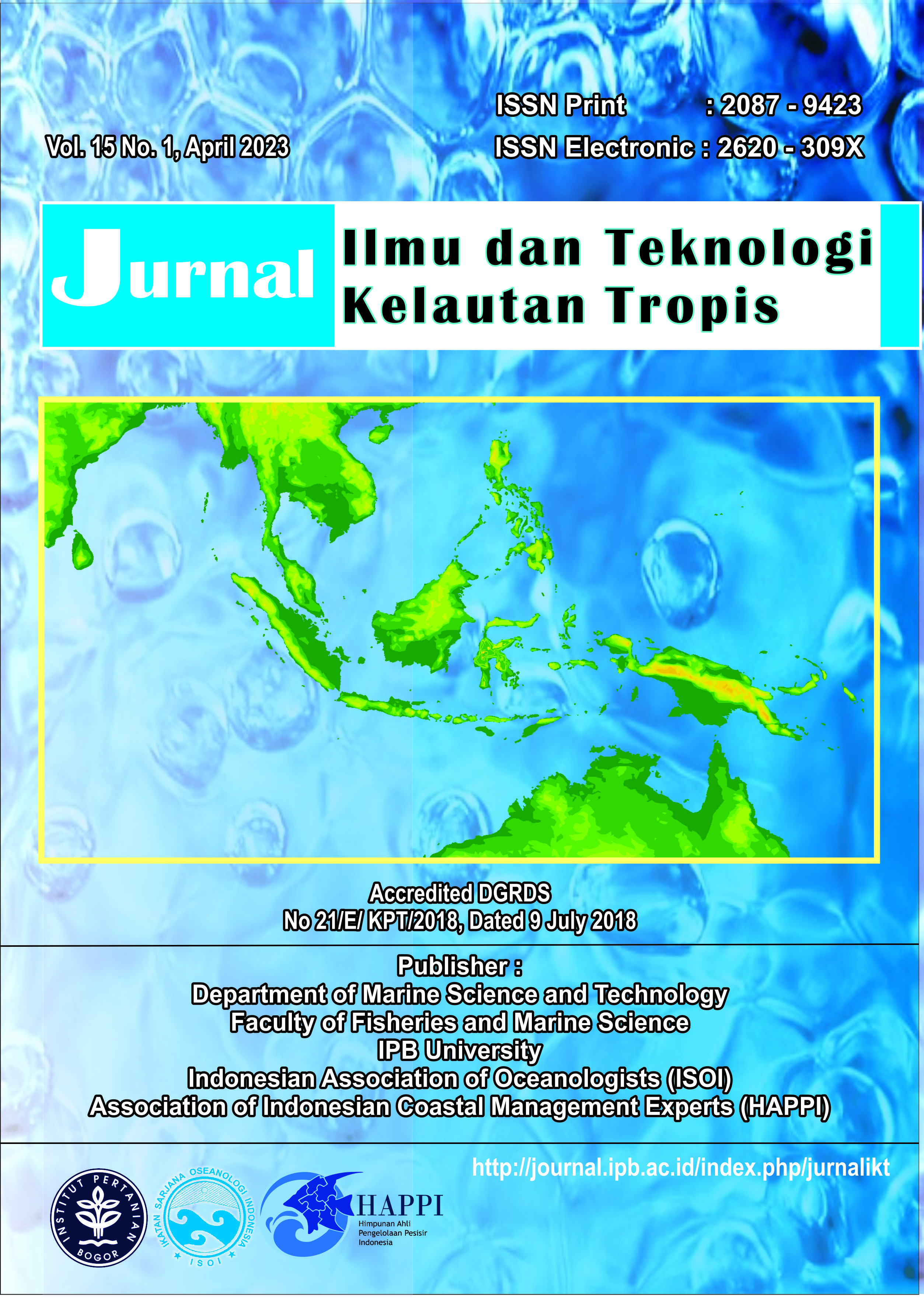STUDY OF WAVE BEHAVIOR DUE TO CYLINDER PILE STRUCTURE THROUGH ENERGY SPECTRUM ANALYSIS
Abstract
Breakwater structures are widely used for coastal protection from the blows of ocean waves that propagate to coastal areas. One of the breakwater innovations being developed is the pile structure. Piles are a replication of mangrove tree trunks that can reduce wave energy, so it is necessary to test their effectiveness in reducing wave energy. So the purpose of this study is to analyze the effectiveness of the pile structure by analyzing the wave behavior before and after colliding with the pile structure based on the wave theory division. Physical laboratory simulations have been carried out to obtain wave data that interacts with the pile structure. Furthermore, energy spectrum analysis is used to determine the energy spectrum of the incident wave, reflection and transmission of wave probe measurements in the form of time series data. Each energy spectrum is used to see the reflection and transmission capabilities of the pile structure from the reflection and transmission coefficients. The reflection and transmission coefficient values were estimated using a third degree polynomial equation resulting in RMSE = 0.087 and RMSE = 0.051 with the basic wave parameters being variable, namely wave height, wave period and water depth. The critical point of the polynomial equation shows the minimum reflection and transmission coefficient values when it is in the Cnoidal region and maximum when it is in the 2nd order Stokes region.
References
Abdullah, F.A.R., T. Suprijo, H. Diastomo, & G. Napitupulu. 2022. Numerical Modelling of Wave Attenuation in Pile Breakwater. In IOP Conference Series: Earth and Environmental Science, 1047(1): 012029. https://doi.org/10.1088/1755-1315/1047/1/012029
Achiari, H., A.L. Ahmad, & D.M. Sulaiman. 2020. Analisis refleksi dan transmisi gelombang pada pemecah gelombang tiang pancang. Jurnal Ilmu dan Teknologi Kelautan Tropis, 12(3): 723-737. https://doi.org/10.29244/jitkt.v12i3.27591
Coastal Engineering Research Center (CERC). 1973. Shore Protection Manual, (Vol. 1). US Army Coastal Engineering Research Center. 250-256.
Costello, R.D. 1952. Damping of water waves by vertical circular cylinders. Eos, Transactions American Geophysical Union, 33(4): 513-519. https://doi.org/10.1029/TR033i004p00513
Eckart, C. 1952. The propagation of gravity waves from deep to shallow water. In Proceedings of NBS Semicentennial Symposium on Gravity Waves Held at the NBS on June, 521: 18-20.
El Serafy, S.Y., Y.E. Mostafa, Y.M. EL Saie, & C.F. Gad. 2015. Investigating the energy dissipation capability of solid piles breakwater., International Journal of Sciences: Basic and Applied Research (IJSBAR), 24(2): 1-13.
Hayashi, T., M. Hattori, T. Kano & M. Shirai. 1966. Hydraulic research on the closely spaced pile breakwater. Coastal Engineering in Japan, 9(1): 107-117. https://doi.org/10.1080/05785634.1966.11924676
Hedges, T.S. & URSEL. 1995. Regions of validity of analytical wave theories. Proceedings of the Institution of Civil Engineers-Water Maritime and Energy, 112(2): 111-114. https://doi.org/10.1680/iwtme.1995.27656
Herbich, J.B. & B. Douglas. 1988. Wave transmission through a double-row pile breakwater. Coastal Engineering Proceedings, 1(21): 165-165. https://doi.org/10.9753/icce.v21.165
Herbich, J.B. 1990. Extent of contaminated marine sediments and cleanup methodology. Coastal Engineering Proceedings, 1(22): 2894-2907. https://doi.org/10.9753/icce.v22.%25p
Kakuno, S. & P.L.F. Liu. 1993. Scattering of water waves by vertical cylinders. Journal of Waterway, Port, Coastal, and Ocean Engineering, 119(3): 302-322. https://doi.org/10.9753/icce.v23.%25p
Lin, C.Y. & C.J. Huang. 2004. Decomposition of incident and reflected higher harmonic waves using four wave gauges. Coastal engineering, 51(5-6), 395-406. https://doi.org/10.1016/j.coastaleng.2004.04.004
Mani, J.S. & S. Jayakumar. 1995. Wave transmission by suspended pipe breakwater. Journal of Waterway, Port, Coastal and Ocean Engineering, 121(6): 335-338. https://doi.org/10.1061/(ASCE)0733-950X(1995)121:6(335)
Mansard, E.P. & E.R. Funke. 1980. The measurement of incident and reflected spectra using a least squares method. Coastal Engineering Proceedings (17:): 8-8. https://doi.org/10.9753/icce.v17.8
Massel, S.R. 2005. Ocean surface waves: their physics and prediction, 11: 270-290. https://doi.org/10.1142/2285
Rao, S., Rao, N.B.S. & V.S. Sathyanarayana. 1999. Laboratory investigation on wave transmission through two rows of perforated hollow piles. Ocean engineering, 26(7): 675-699. https://doi.org/10.1016/S0029-8018(98)00021-3
Sathyanarayana, A.H., P.S. Suvarna, P. Umesh, & K.G. Shirlal. 2021. Performance characteristics of a conical pile head breakwater: An experimental study. Ocean Engineering, 235: 109395. https://doi.org/10.1016/j.oceaneng.2021.109395
Smit, P.B., I.A. Houghton, K. Jordanova, T. Portwood, E. Shapiro, D. Clark, M. Sosa, & T.T. Janssen. 2021. Assimilation of significant wave height from distributed ocean wave sensors. Ocean Modelling, 159, p.101738. https://doi.org/10.1016/j.ocemod.2020.101738
Simanjuntak, E.M., L. Eliasta, J.W. Ginting, & I.A.I.D.R. Putra. 2019. Modelling Wave Dissipation on Pile Breakwater Using Xbeach. Jurnal Teknik Hidraulik, 10(1): 1-14. https://doi.org/10.32679/JTH.V10I1.605
Suh, K.D., C.H. Ji & B.H. Kim. 2011. Closed-form solutions for wave reflection and transmission by vertical slotted barrier. Coastal Engineering, 8(12): 1089-1096. https://doi.org/10.1016/j.coastaleng.2011.06.001
Suh, K.D., S. Shin, & D. Cox. 2006. Hydrodynamic characteristics of pile-supported vertical wall breakwaters. American Society of Civil Engineers, 132(2): 83-96. https://doi.org/10.1177/14750902211031353
Suvarna, P.S., A.H. Sathyanarayana, P. Umesh, & K.G. Shirlal. 2020. Laboratory investigation on hydraulic performance of enlarged pile head breakwater. Ocean Engineering, 217: 107989. https://doi.org/10.1016/j.oceaneng.2020.107989
Truitt, C.L. & J.B. Herbich. 1986. Transmission of random waves through pile breakwaters. Coastal Engineering Proceedings, 20: 169-169. https://doi.org/10.9753/icce.v20.169
Van Weele, B.J. & J.B. Herbich. 1972. Wave reflection and transmission for pile arrays. Coastal Engineering Proceedings, (13): 106-106. https://doi.org/10.9753/icce.v13.106
Wiegel, R.L. 1960. Transmission of waves past a rigid vertical thin barrier. Journal of the Waterways and harbors division, 86(1): 1-12. https://doi.org/10.1061/JWHEAU.0000153
Zhu, X., Y. Cao, J. Zhang, J., E.W. Plummer, & J. Guo. 2015. Classification of charge density waves based on their nature. Proceedings of the National Academy of Sciences, 112(8): 2367-2371. https://doi.org/10.1073/pnas.1424791112
Authors

This work is licensed under a Creative Commons Attribution-ShareAlike 4.0 International License.
The author submitting the manuscript must understand and agree that the copyright of the article manuscript must be submitted/transferred to the Jurnal Ilmu dan Teknologi Kelautan Tropis. This work is licensed under the Creative Commons Attribution-ShareAlike 4.0 (CC BY-SA) International License in which the Author and Reader can copy and redistribute the material in any media or format, and remix, modify and build material for any purpose, but they must provide appropriate credit (citing articles or content), provide a link to the license, and indicate whether there is a change. If you mix, change, or create material, you must distribute your contribution under the same license as the original.


